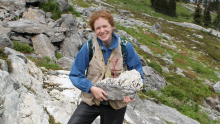UBC researchers have discovered the molecular pathway that enables receptors inside immune cells to find, and flag, fragments of pathogens trying to invade a host.
The discovery of the role played by the molecule CD74 could help immunologists investigate treatments that offer better immune responses against cancers, viruses and bacteria, and lead to more efficient vaccines.
The findings are published in this week’s edition of Nature Immunology.
"This could ultimately lead to a blueprint for improving the performance of a variety of vaccines, including those against HIV, tuberculosis and malaria," says UBC biologist Wilfred Jefferies, whose lab conducted the study. "This detailed understanding of the role of CD74 may also begin to explain differences in immune responses between individuals that could impact personalized medical options in the future."
CD74 is an important piece of cellular machinery inside dendritic cells – which regulate mammalian primary immune responses. Dendritic cells possess specialized pathways that enable them to sense and then respond to foreign threats. Until now no one has been able to piece together the circuitry which enables a cellular receptor – Major Histocompatability Class I (MHC I) – inside the cells to find and ‘collide’ with foreign invaders.
The key finding of this work is the discovery of the guiding role played by CD74 to link MHC I receptors to compartments containing invading pathogens within the immune cell. This sophisticated circuit allows the immune cell to recognize and signal the presence of a pathogen in the body and to alert T immune fighter cells. The T-cells respond by dividing and attacking infected cells, destroying the pathogen.
Jefferies’ team used ‘knock-out’ mice that had been genetically modified to lack the CD74 function to uncover the role of the molecule. The team--which includes research associate Genc Basha, postdoctoral fellow Anna Reinicke, graduate students Kyla Omilusik and Ana Chavez-Steenbock, undergraduate student Nathan Lack, and technician Kyung Bok Choi--then confirmed their findings using biochemical analysis.
Jefferies is a professor with UBC's departments of Microbiology and Immunology, Zoology, and Medical Genetics and with UBC’s Michael Smith Laboratories and Biomedical Research Centre. He is also a member of the Centre for Blood Research and the Brain Research Centre at UBC.
The research was supported by the Canadian Institutes of Health Research and the Michael Smith Foundation for Health Research.
The Nature Immunology study is available at:
http://dx.doi.org/10.1038/ni.2225
Musqueam First Nation land acknowledegement
We honour xwməθkwəy̓ əm (Musqueam) on whose ancestral, unceded territory UBC Vancouver is situated. UBC Science is committed to building meaningful relationships with Indigenous peoples so we can advance Reconciliation and ensure traditional ways of knowing enrich our teaching and research.
Learn more: Musqueam First Nation
Faculty of Science
Office of the Dean, Earth Sciences Building2178–2207 Main Mall
Vancouver, BC Canada
V6T 1Z4


